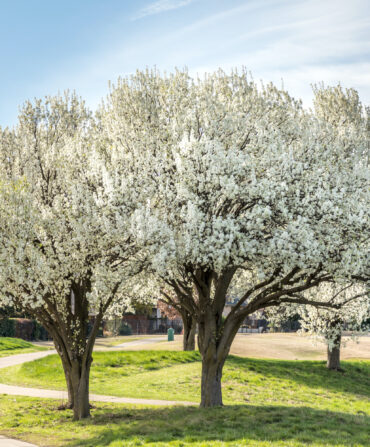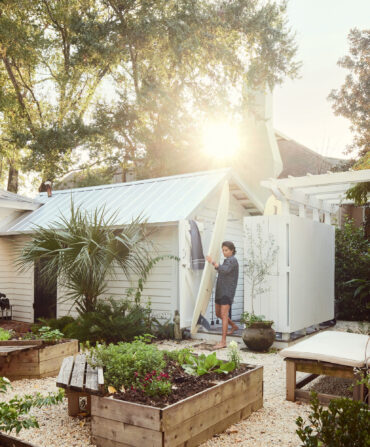It began with thousands of daffodils. They illuminated the woods around the manor, brightening the dappled shade like night-lights. “Then I thought, we need some order to this,” says Troy Rhone, the landscape designer who began sketching out the rooms of a formal garden that would take shape on the private wooded lot of a Birmingham steel heiress, the late Barbara Ingalls Shook. The daffodils stayed, joined by irises in spring and Lenten roses in winter, as walls of sculpted boxwood rose up around them.
This was as unorthodox as any beginning of a formal parterre garden. The epitome of order and symmetry, this genre emerged with the stylized knot gardens of the French Renaissance and grew ever more elaborate in the seventeenth-century baroque gardens that embroidered the grounds of Versailles. Parterres were designed to domesticate nature, training her wild asymmetry into straight lines and strict geometries, all part of a unified plan, and usually in wide-open, sunny spaces.
Now part of the residence of Segal “Ed” Drummond, Jr., a former Drummond Company executive, and his wife, Carolyn, “Cappie,” this garden is a rare parterre in wild woods, like a Fabergé egg among moss. It memorializes a woman as unconventional as the garden she inspired.
Shook herself lived in a Fabergé world, throwing lavish parties and channeling her illimitable verve and wealth into philanthropy. Friends remember her as “a pistol” and “larger than life,” a petite socialite who handled life like a matador. “There was not a dull bone in her body,” says Paula Crockard, a close friend who recalls Shook’s dazzling style and joie de vivre in the face of grave adversity. In her thirties, Shook won her first battle with cancer. It claimed her leg, but not her stride. She carried on, with wit, a prosthesis, and a single crutch. A quiver of crutches, actually, each custom designed to complement her couture.

Photo: Ali Harper
A garden gate leads to a wooded walking trail.
“When I lost my leg, I realized I could do one of two things: sit down in a wheelchair or move on and enjoy life,” she told the Birmingham News in the 1990s. “I decided to go on and enjoy life.” She inspired others to do the same, raising millions for cancer research and treatment. “She shot big game,” says Rex Harris, a lifelong friend. “She skied. She bicycled. She golfed. Whatever she did, she did it all the way.”
In Troy Rhone, Shook found a friend and creative partner, with a vision for a space that would marry discipline with whim. Raised in Birmingham in a family of artists, writers, and gardeners, Rhone has a gift for synchronizing the wild and the cultured that he honed in his grandmother’s backyard in tiny Opp, Alabama. He believes a garden should align with the era and architecture of a home, but also with the personality of its owners. He understood Shook. She trusted him.
“She wanted a putting green and a Japanese cutting and arrangement space, for ikebana,” Rhone says. “The rest she left to me.” He brought her four acres alive with bursts of color from swaths of hydrangeas and camellias, a gently sloping lawn framed by cryptomerias, and a sitting area where benches overlook viburnums bursting white in the spring and Japanese maples blazing red in the fall. His signature flourish is the formal parterre, which echoes the scale and style of the property’s stately brick Georgian home.
Seen from afar, the parterre’s symmetry is balanced and lovely. Up close, it invites wandering and discovery. Like a shadow box, each compartment frames a different objet d’art. Bordering an allée, four inner boxes feature putti—Italianate statues of cherubs—rising from beds of Lenten roses. Outer boxes explode with daffodils and irises in the spring, before overhead leaves cast the space in shade. At the end of the allée, commanding the focal point, is a statue of Diana, goddess of the hunt.
“It’s a statement of who Barbara was,” says Rhone. “It was really fitting.”
Three years after the loss of her husband, Robert, Shook succumbed to cancer in 2008, at the age of sixty-nine. Even her garden seemed to mourn. “You always hear a house has a soul,” says Rhone. “It was almost like the garden and house died with Barbara.” But under the care of their current owners, the Drummonds, both have been restored.
Today, Diana and her putti still hold court in the boxes, watching over their quiet rooms. Historically, parterre gardens served as an architectural extension of a house, designed for viewing from elevation and at a distance. Here beneath the pines and magnolias and Yoshino cherry trees, it’s easy to imagine what the garden looks like when seen from above—a living monogram of the woman who put her indelible stamp on this place.









